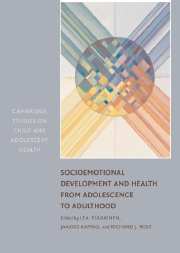Book contents
- Frontmatter
- Contents
- List of Contributors
- Preface
- Introduction
- PART I LONGITUDINAL AND BEHAVIORAL GENETIC APPROACHES
- PART II ADOLESCENT HEALTH-RELATED BEHAVIOR AND ADULT HEALTH
- PART III SOCIOEMOTIONAL BEHAVIOR IN EARLY ADOLESCENCE
- 8 Genetic and Environmental Factors in Girls' and Boys' Socioemotional Behavior
- 9 Emotion Regulation and Well-Being
- 10 Parental Knowledge and Family Atmosphere in Relation to Children's Socioemotional Behavior
- 11 Parental Work and Children's Behavior: The Mediator Roles of Partner Relationship and Parenthood
- 12 Grandparents as Resource Factors in the Family
- PART IV LIFE COURSE AND HEALTH
- Summary and Future Directions
- References
- Author Index
- Subject Index
9 - Emotion Regulation and Well-Being
Published online by Cambridge University Press: 07 December 2009
- Frontmatter
- Contents
- List of Contributors
- Preface
- Introduction
- PART I LONGITUDINAL AND BEHAVIORAL GENETIC APPROACHES
- PART II ADOLESCENT HEALTH-RELATED BEHAVIOR AND ADULT HEALTH
- PART III SOCIOEMOTIONAL BEHAVIOR IN EARLY ADOLESCENCE
- 8 Genetic and Environmental Factors in Girls' and Boys' Socioemotional Behavior
- 9 Emotion Regulation and Well-Being
- 10 Parental Knowledge and Family Atmosphere in Relation to Children's Socioemotional Behavior
- 11 Parental Work and Children's Behavior: The Mediator Roles of Partner Relationship and Parenthood
- 12 Grandparents as Resource Factors in the Family
- PART IV LIFE COURSE AND HEALTH
- Summary and Future Directions
- References
- Author Index
- Subject Index
Summary
INTRODUCTION
After decades of neglect, psychology rediscovered emotion in the 1980s (Gross, 1999a). Although there is still controversy about how emotions should be defined, the current definitions emphasize their dynamic, functional, and adaptive nature. However, profiting from the adaptive features of emotion requires effective emotion regulation (Paivio & Laurent, 2001). Given the lack of consensus on the definition of emotion, it is unsurprising that emotion regulation, grown out of the earlier lines of research into stress, coping, and temperament, and out of psychoanalytic research (Eisenberg, 1998; Gross, 1999b), also has been defined in various ways.
The concept of emotion regulation has sometimes been used when emotions have been regarded as inherently regulatory, influencing, for example, physiological and social processes. Probably more often, however, emotions have been seen as the targets of regulation, and emotion regulation has referred to the processes of initiating, maintaining, modulating, or changing the occurrence, intensity, or duration of emotion-related physiological processes and internal feeling states, which often serve the attainment of one's goals (Eisenberg, Fabes, Guthrie, & Reiser, 2000). This dynamic view of emotion regulation emphasizes the fact that emotions can be regulated.
The lack of clarity in the definition has been due in part to the large number of similar concepts. For instance, some researchers have considered emotion regulation a synonym for coping (Brenner & Salovey, 1997, p. 170) or a type of coping (Eisenberg, Fabes, & Losoya, 1997), notably emotion-focused coping (e.g., Eisenberg, 1998).
- Type
- Chapter
- Information
- Publisher: Cambridge University PressPrint publication year: 2006
- 5
- Cited by



